The North Dakota League of Cities was founded in Grand Forks, North Dakota, in 1912. It serves as a key resource for cities and park districts in North Dakota and also represents the interests of municipalities in state and federal public policy discussions. It is now located in Bismarck, North Dakota.
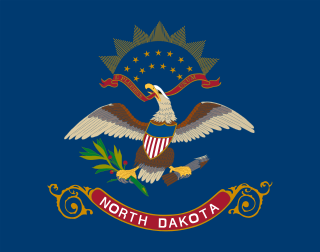
North Dakota is a landlocked U.S. state in the Upper Midwest, named after the indigenous Dakota Sioux. It is bordered by the Canadian provinces of Saskatchewan and Manitoba to the north and by the U.S. states of Minnesota to the east, South Dakota to the south, and Montana to the west. North Dakota is part of the Great Plains region, characterized by broad prairies, steppe, temperate savanna, badlands, and farmland. North Dakota is the 19th largest state, but with a population of less than 780,000, it is the 4th least populous and 4th most sparsely populated. The state capital is Bismarck while the most populous city is Fargo, which accounts for nearly a fifth of the state's population; both cities are among the fastest-growing in the U.S., although half of all residents live in rural areas.

South Dakota is a landlocked state in the North Central region of the United States. It is also part of the Great Plains. South Dakota is named after the Dakota Sioux tribe, which comprises a large portion of the population with nine reservations currently in the state and has historically dominated the territory. South Dakota is the 17th largest by area, but the 5th least populous, and the 5th least densely populated of the 50 United States. Pierre is the state capital, and Sioux Falls, with a population of about 213,900, is South Dakota's most populous city. The state is bisected by the Missouri River, dividing South Dakota into two geographically and socially distinct halves, known to residents as "East River" and "West River". South Dakota is bordered by North Dakota to the north, Minnesota to the east, Iowa to the southeast, Nebraska to the south, Wyoming to the west, and Montana to the northwest.

Bismarck is the capital of the U.S. state of North Dakota and the county seat of Burleigh County. It is the state's second-most populous city, after Fargo. The population was 73,622 at the 2020 census, and was estimated to be 75,092 in 2023, while its metropolitan population was 133,626. In 2020, Forbes magazine ranked Bismarck as the seventh fastest-growing small city in the United States.

The Missouri Valley Football Conference (MVFC), formerly the Gateway Football Conference, is a collegiate athletic conference which operates in the Midwestern United States. It participates in the NCAA's Division I Football Championship Subdivision (FCS) as a football-only conference.

Fargo is the most populous city in the U.S. state of North Dakota and the county seat of Cass County. The population was 125,990 at the 2020 census, which was estimated to have grown to 133,188 in 2023, making it the 218th-most populous city in the United States. Fargo, along with its twin city of Moorhead, Minnesota, form the core of the Fargo–Moorhead metropolitan statistical area, which had a population of 248,591 in 2020.

Dickinson is a city in and the county seat of Stark County, North Dakota, United States. The population was 25,679 at the 2020 census, and was estimated to be 24,979 in 2022, making it the 7th most populous city in North Dakota. Dickinson is home to the Ukrainian Cultural Institute, which has a museum and holds events year round for the local Ukrainian community. Western North Dakota has a high concentration of people of Ukrainian descent.

The Nonpartisan League (NPL) was a left-wing political party founded in 1915 in North Dakota by Arthur C. Townley, a former organizer for the Socialist Party of America. On behalf of small farmers and merchants, the Nonpartisan League advocated state control of mills, grain elevators, banks, and other farm-related industries in order to reduce the power of corporate and political interests from Minneapolis and Chicago.
The North Dakota Democratic–Nonpartisan League Party is the North Dakota affiliate of the national Democratic Party. It was formed as the outcome of a merger of two parties; the state previously had a three-party political system. It is one of only two state Democratic Party affiliates to have a different name from the central party, the other being the neighboring Minnesota Democratic–Farmer–Labor Party. The party currently has very weak electoral power in the state, controlling none of North Dakota's statewide or federal elected offices.

The North Dakota Republican Party is the North Dakota affiliate of the United States Republican Party.

The Summit League, or The Summit, is an NCAA Division I intercollegiate athletic conference with its membership mostly located in the Midwestern United States, from Minnesota in the east, to the Dakotas, Nebraska and Colorado to the West, and Missouri and Oklahoma to the South. Founded as the Association of Mid-Continent Universities in 1982, it rebranded as the Mid-Continent Conference in 1989, then again as the Summit League on June 1, 2007. The league headquarters are in Sioux Falls, South Dakota.

North Dakota was first settled by Native Americans several thousand years ago. The first Europeans explored the area in the 18th century establishing some limited trade with the natives.

The North Dakota Fighting Hawks are the athletic teams that represent the University of North Dakota (UND), located in the city of Grand Forks, North Dakota. The Fighting Hawks compete at the National Collegiate Athletic Association Division I level as a member of the Summit League. With 17 varsity teams, North Dakota is best known for its Ice Hockey team and American Football team. North Dakota's main rivalries are with the North Dakota State Bison and the Minnesota Golden Gophers.
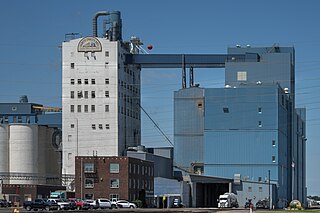
The North Dakota Mill and Elevator is the largest flour mill in the United States. It is located in the city of Grand Forks, North Dakota. Established by the state government when it was led by Nonpartisan League representatives, it is the only state-owned milling facility in the United States. It is overseen by the North Dakota Industrial Commission, whose members are all public officers elected by popular vote.
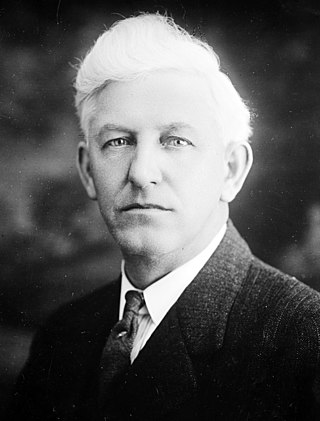
Arthur Gustave Sorlie was an American businessman and politician who served as the 14th Governor of North Dakota from 1925 until his death in 1928 at the age of 54.
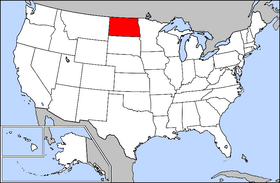
The North Dakota High School Activities Association (NDHSAA) is the governing body for the U.S. state of North Dakota's high-school athletics and fine arts. The current executive director of the NDHSAA is Matthew Fetsch and the headquarters are located in Valley City, North Dakota.

The 2020 United States House of Representatives election in South Dakota was held on November 3, 2020, to elect the U.S. representative from South Dakota's at-large congressional district. The election coincided with the 2020 U.S. presidential election, as well as other elections to the House of Representatives, elections to the United States Senate and various state and local elections.

The 2020 United States House of Representatives election in North Dakota was held on November 3, 2020, to elect the U.S. representative from North Dakota's at-large congressional district. The election coincided with the 2020 U.S. presidential election, as well as other elections to the House of Representatives, elections to the United States Senate and various state and local elections.
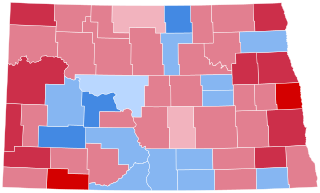
The 1928 United States presidential election in North Dakota took place on November 6, 1928, as part of the 1928 United States presidential election which was held throughout all contemporary 48 states. Voters chose five representatives, or electors to the Electoral College, who voted for president and vice president.

The 1924 North Dakota gubernatorial election was held on November 4, 1924.
The 1939 North Dakota Agricultural Bison football team was an American football team that represented North Dakota Agricultural College in the North Central Conference (NCC) during the 1939 college football season. In its 11th season under head coach Casey Finnegan, the team compiled a 1–6–1 record and finished in seventh place out of seven teams in the NCC.